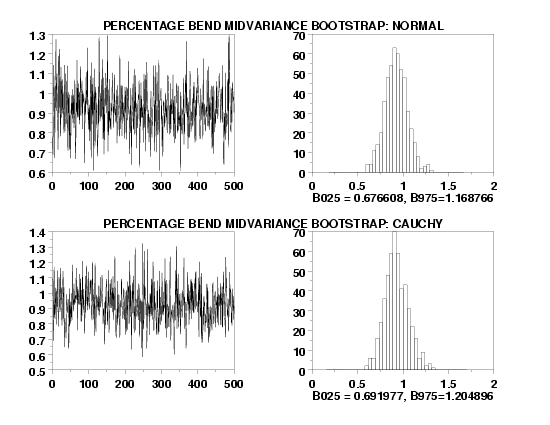

|
PERCENTAGE BEND MIDVARIANCEName:
Many statistics have one of these properties. However, it can be difficult to find statistics that are both resistant and have robustness of efficiency. For scale estimaors, the variance is an optimal estimator for Gaussian data. However, it is not resistant and it does not have robustness of efficiency. The rationale for this estimate is given in these references. The percentage bend midvariance estimator, discussed in Shoemaker and Hettmansperger and also by Wilcox, is both resistant and robust of efficiency. The percentage bend midvariance of a a variable X is computed as follows:
The value of \( \beta \) is selected between 0 and 0.5. Higher values of \( \beta \) is selected result in a higher breakdown point at the expense of lower efficiency.
where <y> is the response variable; <par> is a parameter where the computed percentage bend midvariance is stored; and where the <SUBSET/EXCEPT/FOR qualification> is optional.
LET A = PERCENTAGE BEND MIDVARIANCE Y1 SUBSET TAG > 2
where <value> is greater than 0 and less than or equal to 0.5. The default value for \( \beta \) is 0.1.
Rand Wilcox (1997), "Introduction to Robust Estimation and Hypothesis Testing", Academic Press. Mosteller and Tukey (1977), "Data Analysis and Regression: A Second Course in Statistics", Addison-Wesley, pp. 203-209.
LET Y1 = NORMAL RANDOM NUMBERS FOR I = 1 1 100
LET Y2 = LOGISTIC RANDOM NUMBERS FOR I = 1 1 100
LET Y3 = CAUCHY RANDOM NUMBERS FOR I = 1 1 100
LET Y4 = DOUBLE EXPONENTIAL RANDOM NUMBERS FOR I = 1 1 100
LET A1 = PERCENTAGE BEND MIDVARIANCE Y1
LET A2 = PERCENTAGE BEND MIDVARIANCE Y2
LET A3 = PERCENTAGE BEND MIDVARIANCE Y3
LET A4 = PERCENTAGE BEND MIDVARIANCE Y4
Program 2:
MULTIPLOT 2 2
MULTIPLOT CORNER COORDINATES 0 0 100 100
MULTIPLOT SCALE FACTOR 2
X1LABEL DISPLACEMENT 12
.
LET Y1 = NORMAL RANDOM NUMBERS FOR I = 1 1 200
LET Y2 = CAUCHY RANDOM NUMBERS FOR I = 1 1 200
.
BOOTSTRAP SAMPLES 500
BOOTSTRAP PERCENTAGE BEND MIDVARIANCE PLOT Y1
X1LABEL B025 = ^B025, B975=^B975
HISTOGRAM YPLOT
X1LABEL
.
BOOTSTRAP PERCENTAGE BEND MIDVARIANCE PLOT Y1
X1LABEL B025 = ^B025, B975=^B975
HISTOGRAM YPLOT
.
END OF MULTIPLOT
JUSTIFICATION CENTER
MOVE 50 96
TEXT PERCENTAGE BEND MIDVARIANCE BOOTSTRAP: NORMAL
MOVE 50 46
TEXT PERCENTAGE BEND MIDVARIANCE BOOTSTRAP: CAUCHY

|
Privacy
Policy/Security Notice
NIST is an agency of the U.S.
Commerce Department.
Date created: 07/22/2002 | ||||||||||||||||||